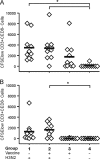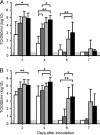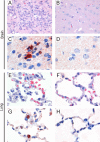Vaccination against seasonal influenza A/H3N2 virus reduces the induction of heterosubtypic immunity against influenza A/H5N1 virus infection in ferrets
- PMID: 21228239
- PMCID: PMC3067975
- DOI: 10.1128/JVI.02371-10
Vaccination against seasonal influenza A/H3N2 virus reduces the induction of heterosubtypic immunity against influenza A/H5N1 virus infection in ferrets
Abstract
Infection with seasonal influenza viruses induces a certain extent of protective immunity against potentially pandemic viruses of novel subtypes, also known as heterosubtypic immunity. Here we demonstrate that infection with a recent influenza A/H3N2 virus strain induces robust protection in ferrets against infection with a highly pathogenic avian influenza virus of the H5N1 subtype. Prior H3N2 virus infection reduced H5N1 virus replication in the upper respiratory tract, as well as clinical signs, mortality, and histopathological changes associated with virus replication in the brain. This protective immunity correlated with the induction of T cells that cross-reacted with H5N1 viral antigen. We also demonstrated that prior vaccination against influenza A/H3N2 virus reduced the induction of heterosubtypic immunity otherwise induced by infection with the influenza A/H3N2 virus. The implications of these findings are discussed in the context of vaccination strategies and vaccine development aiming at the induction of immunity to pandemic influenza.
Figures





References
-
- Benton, K. A., et al. 2001. Heterosubtypic immunity to influenza A virus in mice lacking IgA, all Ig, NKT cells, or gamma delta T cells. J. Immunol. 166:7437-7445. - PubMed
-
- Bernstein, D. I., et al. 2008. Effects of adjuvants on the safety and immunogenicity of an avian influenza H5N1 vaccine in adults. J. Infect. Dis. 197:667-675. - PubMed
-
- Bodewes, R., et al. 2010. Vaccination with whole inactivated virus vaccine affects the induction of heterosubtypic immunity against influenza virus A/H5N1 and immunodominance of virus-specific CD8+ T-cell responses in mice. J. Gen. Virol. 91:1743-1753. - PubMed
-
- Bodewes, R., J. H. Kreijtz, and G. F. Rimmelzwaan. 2009. Yearly influenza vaccinations: a double-edged sword? Lancet Infect. Dis. 9:784-788. - PubMed
Publication types
MeSH terms
Substances
LinkOut - more resources
Full Text Sources
Medical

